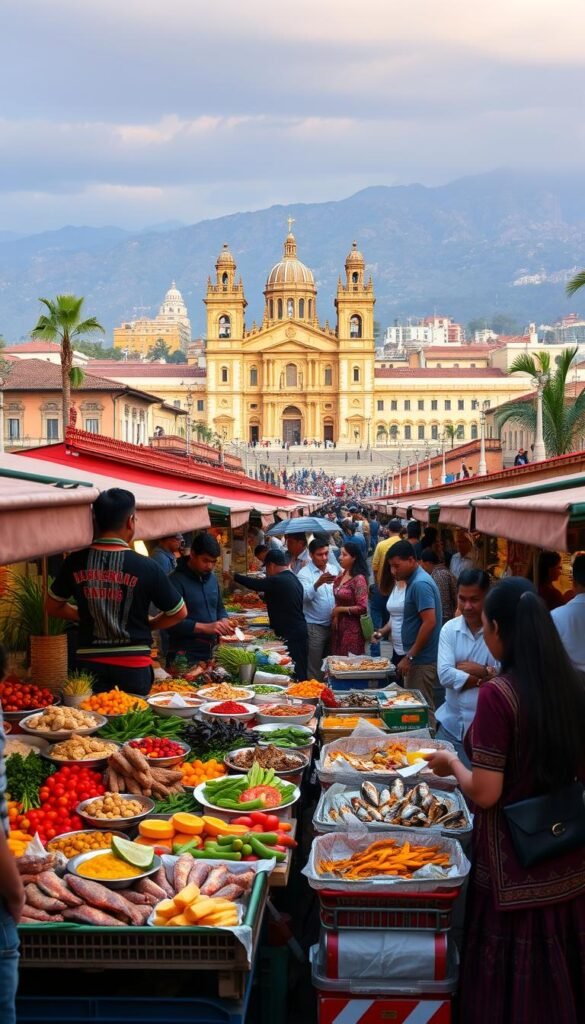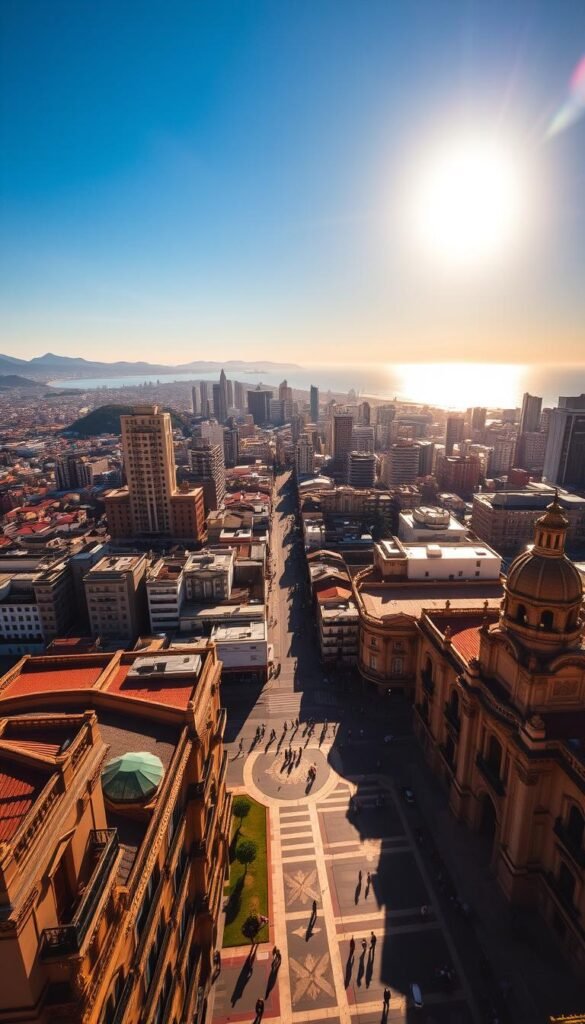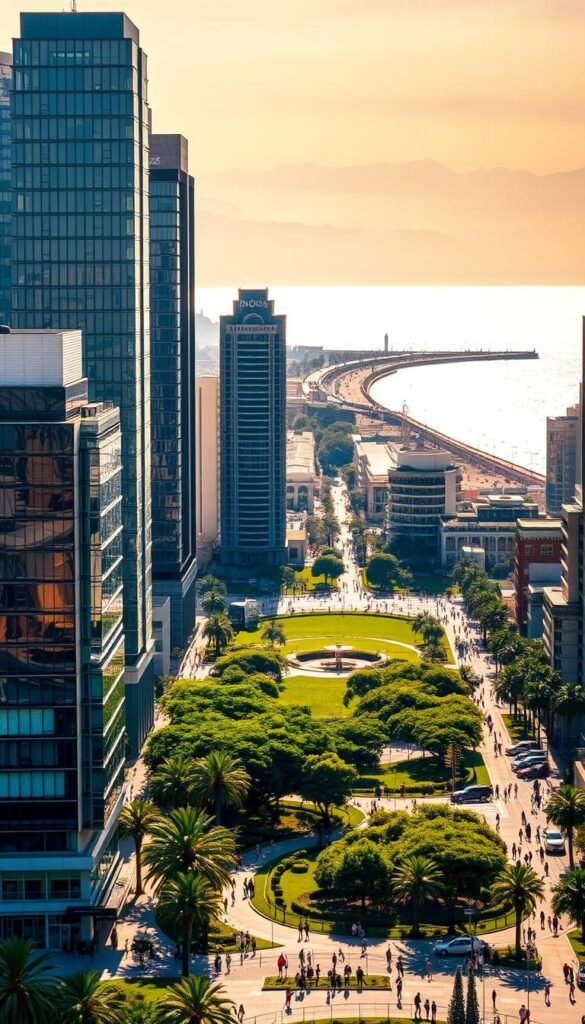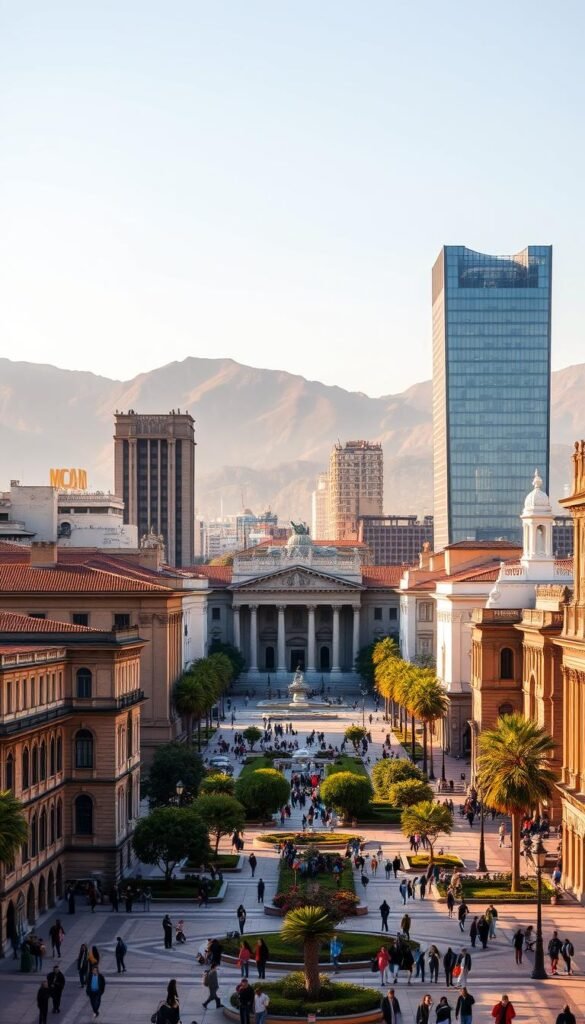
Peru’s coastal capital city, Lima, is a treasure trove of experiences, showcasing world-class gastronomy, ancient ruins, and breathtaking natural landscapes. As a leading tourist destination, Lima seamlessly blends modern attractions with its rich cultural heritage.
Visitors can indulge in the city’s renowned culinary scene, sampling local delicacies that reflect the country’s diverse cultural influences. From traditional eateries to modern restaurants, Lima’s food scene is a melting pot of flavors and techniques.
Key Takeaways
- Discover Lima’s must-see historical sites and landmarks.
- Experience the city’s vibrant culinary scene and local cuisine.
- Explore the surrounding natural landscapes and ancient ruins.
- Learn about Lima’s rich cultural heritage and its significance.
- Find the best local eateries and restaurants serving traditional Peruvian dishes.
Discovering Peru’s Vibrant Capital
As the heart of Peru, Lima pulsates with a vibrant energy that combines urban chic with historical depth. This metropolitan capital is a treasure trove of experiences, from its modern attractions to its rich cultural heritage.
Lima’s urban landscape is dotted with numerous Lima attractions that showcase its diverse spirit. Some of the top Lima sightseeing spots include:
- Historic Center, a UNESCO World Heritage site
- Miraflores, known for its modern face and vibrant nightlife
- Barranco, the bohemian district with its artistic vibe
When planning your trip, consider exploring these areas to get a comprehensive feel of the city. Insider tips suggest visiting during the summer months (December to April) for the best experience.

Lima is not just about sightseeing; it’s also about immersing yourself in its culture. The city’s culinary scene, museums, and local traditions offer a deep dive into Peruvian life.
Start planning your trip now with our insider’s list of unmissable experiences in Lima, and get ready to discover the best of Peru’s vibrant capital.
Lima Sites to See and Top Food to Eat: An Overview
From ancient ruins to contemporary cuisine, Lima offers a diverse array of experiences for visitors. The city is a treasure trove of Lima tourist spots, ranging from historical landmarks to modern attractions.
One of the top experiences in Lima is exploring its vibrant districts, each with its unique character. For instance, the historic center is a must-visit area, filled with colonial-era architecture and significant landmarks.
- Visit the Plaza de Armas, the heart of Lima’s historic center.
- Explore the catacombs beneath the San Francisco Monastery.
- Enjoy the scenic views of the coastline in Miraflores.
Lima is also renowned for its culinary scene, offering a wide range of delicious Peruvian dishes. Some of the must-try foods include ceviche, a refreshing dish made from raw fish marinated in citrus juices, and lomo saltado, a hearty stir-fry that combines beef, vegetables, and French fries.
“Lima’s gastronomy is a reflection of its cultural diversity, blending indigenous, Spanish, African, and Asian influences.”
For those looking to experience the best of Lima, there are numerous Lima must-visit places to explore, from museums and art galleries to outdoor activities like paragliding over the city and coast.

In summary, Lima is a city that offers something for everyone, whether you’re interested in history, culture, food, or adventure. Its diverse attractions and culinary delights make it a top destination for travelers.
Historic Center of Lima: UNESCO World Heritage
Lima’s Historic Center, a UNESCO World Heritage site, is rich in cultural significance. This historic area is a testament to the city’s rich history, showcasing a blend of pre-Columbian and Spanish influences. As visitors stroll through the historic center, they are surrounded by impressive architecture, historic landmarks, and vibrant cultural activities.
The Historic Center of Lima is not only a significant cultural hub but also a popular tourist destination. Its well-preserved architecture and historic buildings provide a glimpse into the city’s past, making it an essential visit for history buffs and travelers alike.
Notable Buildings and Photo Opportunities
The Historic Center is home to numerous notable buildings, each with its own unique history and architectural style. Some of the most notable landmarks include the Lima Cathedral, the Government Palace, and the Municipal Palace. These buildings offer ample photo opportunities, with their intricate details and stunning architecture.
| Landmark | Description | Photo Opportunity |
|---|---|---|
| Lima Cathedral | A stunning example of colonial architecture, the Lima Cathedral is a must-visit landmark. | Capture the intricate stone carvings and stunning facade. |
| Government Palace | The seat of the Peruvian government, this palace is an impressive example of Spanish colonial architecture. | Take a photo of the changing of the guard ceremony. |
| Municipal Palace | A beautiful example of neoclassical architecture, the Municipal Palace is a great spot for photos. | Capture the stunning architecture and vibrant street life. |
Visitors to the Historic Center of Lima can easily spend a day exploring the area, taking in the history, architecture, and culture. With its rich heritage and numerous landmarks, it is a destination that is sure to leave a lasting impression.
Miraflores: Lima’s Modern Face
Lima’s modern face is perhaps best represented in Miraflores, where contemporary and historical elements blend seamlessly. This district is a hub of activity, offering visitors a wide range of experiences that showcase the best of Lima’s modern charm.
Miraflores is known for its vibrant cultural scene, beautiful parks, and stunning coastal views. One of the district’s main attractions is the Malecón, a scenic walkway along the cliffs overlooking the Pacific Ocean. Here, visitors can enjoy breathtaking views, especially during sunset.

The district is also home to a variety of shopping centers, restaurants, and nightlife venues, making it a great place to experience Lima’s modern lifestyle. For those interested in outdoor activities, Miraflores offers several parks and gardens, as well as opportunities for surfing and paragliding.
Booking Tips and Best Times for Activities
To make the most of your visit to Miraflores, it’s advisable to plan ahead. Booking tours and activities in advance can help avoid long wait times and ensure availability. For outdoor activities like surfing or paragliding, the best times are typically early morning or late afternoon when the weather conditions are optimal.
As one visitor noted, “Miraflores is a district that has something for everyone, from its beautiful landscapes to its vibrant cultural scene.” This sentiment is echoed by many who visit Miraflores, drawn by its unique blend of modern attractions and traditional Peruvian culture.
“The modernity of Miraflores is captivating, with its sleek skyscrapers and trendy restaurants, yet it retains a deep connection to its historical roots.”
Whether you’re interested in history, culture, or simply enjoying the modern amenities, Miraflores is a must-visit destination in Lima. With its blend of old and new, it offers a unique and memorable experience for visitors from around the world.
Barranco: The Bohemian District
The bohemian charm of Barranco makes it a standout district in Lima. Known for its vibrant cultural scene, Barranco is a hub for artists, musicians, and travelers alike. This eclectic neighborhood is characterized by its colorful street art, trendy boutiques, and lively restaurants.

As the sun sets, Barranco transforms into a hotspot for nightlife. The district is home to a variety of bars, clubs, and live music venues that cater to all tastes. From traditional Peruvian music to modern electronic beats, Barranco’s nightlife scene is diverse and exciting.
Nightlife and Live Music Venues
Barranco’s nightlife is centered around Avenida Pedro de Osma, where you’ll find some of the district’s most popular venues. These include live music bars that host local musicians and bands, as well as dance clubs that stay open until the early hours of the morning.
- La Noche de Barranco: A legendary nightlife spot known for its live music and dancing.
- Huaca Pucllana: While not exclusively a nightlife venue, it often hosts evening events and live music.
- Bar Inglés: A popular bar that offers a wide range of cocktails and live music performances.
Whether you’re looking for a relaxed evening out or an all-night dance party, Barranco has something to offer. Its bohemian vibe and lively atmosphere make it a must-visit destination in Lima.
Must-Visit Museums in Lima
Lima’s vibrant cultural scene is perhaps best represented by its diverse array of museums, each offering a unique perspective on Peruvian history and art.
The city is home to a variety of museums that showcase its rich cultural heritage. One of the most notable is the National Museum of Anthropology, Archaeology, and History, which houses an extensive collection of artifacts that tell the story of Peru’s past, from pre-Columbian civilizations to the present day.

Another must-visit is the Museo de Arte, which features a collection of Peruvian art from the colonial period to the present, including works by renowned artists.
English-Language Tours and Guides
Many of Lima’s museums offer English-language tours and guides, making it easier for international visitors to appreciate the exhibits. For instance, the Museo Nacional de Antropología, Arqueología e Historia del Perú often provides guided tours in English, enhancing the visitor experience.
Whether you’re interested in history, art, or anthropology, Lima’s museums have something to offer. Be sure to check the opening hours and tour schedules for each museum to plan your cultural exploration effectively.
Essential Peruvian Dishes to Try in Lima
Peruvian cuisine, with its unique blend of indigenous, Spanish, African, and Asian influences, is a must-experience when visiting Lima. The city’s culinary scene is a reflection of its rich cultural heritage, offering a diverse range of traditional dishes that are sure to delight any palate.
One of the most iconic Peruvian dishes is Ceviche, a refreshing seafood dish made from fresh fish marinated in citrus juices. Another staple is Lomo Saltado, a stir-fry that combines beef, vegetables, and French fries, showcasing the Chinese influence on Peruvian cuisine.
Other must-try dishes include Anticuchos, grilled beef heart skewers that are typically served as a street food, and Aji de Gallina, a creamy chicken dish made with shredded chicken cooked in aji amarillo pepper sauce. For those with a sweet tooth, Suspiro de Limeña, a traditional Peruvian dessert, is a must-try.
Food Allergies and Dietary Restrictions
When exploring Peruvian cuisine, it’s essential to consider food allergies and dietary restrictions. Many traditional dishes contain common allergens such as seafood, nuts, and dairy. For vegetarians and vegans, options can be limited, but many restaurants now offer plant-based versions of classic dishes.
| Dish | Common Allergens | Dietary Classification |
|---|---|---|
| Ceviche | Seafood | Pescatarian, Gluten-free |
| Lomo Saltado | None | Contains Gluten, Not suitable for Vegetarians/Vegans |
| Aji de Gallina | Dairy | Not suitable for Vegans, Contains Gluten |
| Anticuchos | None | Gluten-free, Not suitable for Vegetarians/Vegans |
Understanding these dietary considerations can help visitors navigate Lima’s culinary landscape more effectively, ensuring that they can enjoy the essential Peruvian dishes without concern.
Lima’s Top Dining Experiences
Lima’s culinary scene is a vibrant tapestry of traditional and modern flavors, offering some of the most unforgettable dining experiences in South America. The city’s restaurants are a testament to its rich gastronomic heritage, blending indigenous, Spanish, African, and Asian influences.
For a truly immersive experience, visitors should explore the various districts, each offering a unique dining atmosphere. Miraflores, for instance, is known for its modern and upscale eateries, while Barranco offers a more bohemian vibe with its eclectic mix of restaurants and bars.
Reservations and Tipping Etiquette
When dining at Lima’s top restaurants, it’s advisable to make reservations in advance, especially on weekends or during peak dining hours. Tipping etiquette in Lima is generally similar to that in the United States, with 10% being a standard tip for good service.
- Some of the best restaurants in Lima include Central Restaurante, known for its innovative Peruvian cuisine, and Maido, which offers a unique blend of Peruvian-Japanese flavors.
- For a more casual dining experience, visitors can explore the local markets or try some of the street food available in various districts.
As one culinary expert noted, “Lima’s dining scene is not just about the food; it’s about the experience. From the vibrant atmosphere to the exceptional service, every meal is a celebration of Peruvian culture.”
“The culinary identity of Lima is a reflection of its diverse cultural heritage, making it a fascinating destination for food lovers.”
In conclusion, Lima’s top dining experiences offer a rich and varied culinary journey. Whether you’re in the mood for traditional Peruvian dishes or modern fusion cuisine, the city’s best restaurants are sure to impress.
Culinary Experiences Beyond Restaurants
Beyond the plate, Lima’s culinary culture is alive and thriving in various forms. The city’s passion for food is evident in its vibrant markets, cooking classes, and food festivals, offering visitors a chance to immerse themselves in Peruvian cuisine beyond just dining out.
One of the most engaging ways to experience Lima’s culinary delights is through cooking classes. Many local chefs offer classes where you can learn to prepare traditional Peruvian dishes. These classes not only teach you about the ingredients and techniques used in Peruvian cooking but also provide insight into the cultural significance of various dishes.
Visiting local markets is another way to experience the city’s culinary culture. Markets like Mercado Central offer a sensory overload of sights, smells, and tastes. Here, you can sample local produce, cheeses, and prepared dishes, gaining a deeper understanding of the ingredients and flavors that define Peruvian cuisine.
Bringing Peruvian Flavors Home
After experiencing the rich culinary landscape of Lima, you might wonder how to bring these flavors back home. One of the simplest ways is to recreate Peruvian dishes using local ingredients. Many Peruvian recipes rely on ingredients that are readily available in international markets or can be substituted with local alternatives.
As celebrity chef, Gastón Acurio, once said, “Peruvian cuisine is not just about the food; it’s about the culture, the people, and the land.” This philosophy can guide you in your culinary journey, whether you’re cooking at home or exploring Lima’s culinary scene.
To start, try making ceviche or lomo saltado, two popular dishes that showcase the flavors and techniques of Peruvian cuisine. With a bit of practice, you’ll be able to bring a taste of Lima back to your kitchen.
Making the Most of Your Lima Adventure
Lima offers a unique adventure for visitors, with its rich culture, history, and gastronomy. To make the most of your Lima adventure, consider exploring the city’s diverse districts, each with its own character and charm.
From the historic center to the bohemian neighborhood of Barranco, there’s no shortage of exciting experiences to be had. Be sure to indulge in the local cuisine, which showcases the best of Peruvian flavors and ingredients. With its world-class restaurants and vibrant markets, Lima is a food lover’s paradise.
To truly make the most of your visit, take time to wander the city’s streets, soak up the atmosphere, and engage with the locals. Whether you’re a history buff, a foodie, or simply looking for a new adventure, Lima has something for everyone. With its warm climate, rich heritage, and infectious energy, Lima is a destination that will leave you wanting more.